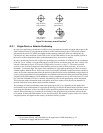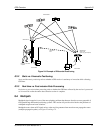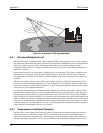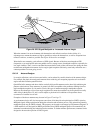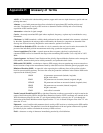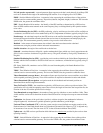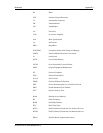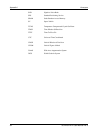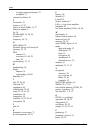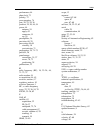
78 SUPERSTAR II User Manual Rev 3
Appendix H Glossary of Terms
P-Code (precise or protected) - a spread spectrum direct sequence code that is used primarily by military GPS
receivers to determine the range to the transmitting GPS satellite. Uses a chipping rate of 10.23 MHz.
PDOP - Position Dilution of Precision - A numerical value expressing the confidence factor of the position
solution based on current satellite geometry. 3D position (latitude, longitude, height) is unknown. The lower the
PDOP value, the greater the confidence factor.
PRN - Pseudo-Random Noise number - the identify of the GPS satellites as determined by a GPS receiver.
Since all GPS satellites must transmit on the same frequency, they are distinguished by their pseudo-random
noise codes.
Precise Positioning Service (PPS) - the GPS positioning, velocity, and time service which will be available on
a continuous, worldwide basis to users authorized by the U.S. Department of Defense (typically using P-Code).
Pseudorange - the calculated range from the GPS receiver to the satellite determined by taking the difference
between the measured satellite transmit time and the receiver time of measurement, and multiplying by the
speed of light. This measurement generally contains a large receiver clock offset error.
Residual - in the context of measurements, the residual is the misclosure between the calculated
measurements, using the position solution and actual measurements.
Satellite elevation - the angle of the satellite above the horizon.
Spheroid - sometimes known as ellipsoid; a perfect mathematical figure which very closely approximates the
geoid. Used as a surface of reference for geodetic surveys. The geoid, affected by local gravity disturbances, is
irregular.
Standard Positioning Service (SPS) - a positioning service made available by the United States Department of
Defense which will be available to all GPS civilian users on a continuous, worldwide basis (typically using C/
A code)
SV - Space Vehicle ID, sometimes used as SVID; also used interchangeably with Pseudo-Random Noise
Number (PRN).
TDOP - Time Dilution of Precision - A numerical value expressing the confidence factor of the position
solution based on current satellite geometry. The lower the TDOP value, the greater the confidence factor.
Three-dimensional coverage (hours) - the number of hours-per-day when four or more satellites are available
with acceptable positioning geometry. Four visible satellites are required to determine location and altitude.
Three-dimensional (3D) navigation - navigation mode in which altitude and horizontal position are
determined from satellite range measurements.
Time-To-First-Fix (TTFF) - the actual time required by a GPS receiver to achieve a position solution. This
specification will vary with the operating state of the receiver, the length of time since the last position fix, the
location of the last fix, and the specific receiver design.
Two-dimensional coverage (hours) - the number of hours-per-day with three or more satellites visible. Three
visible satellites can be used to determine location if the GPS receiver is designed to accept an external altitude
input.
Undulation - the distance of the geoid above (positive) or below (negative) the mathematical reference
ellipsoid (spheroid). Also known as geoidal separation, geoidal undulation, geoidal height.
Universal Time Coordinated (UTC) - this time system uses the second-defined true angular rotation of the
Earth measured as if the Earth rotated about its Conventional Terrestrial Pole. However, UTC is adjusted only
in increments of one second. The time zone of UTC is that of Greenwich Mean Time (GMT).
Update rate - the GPS receiver specification which indicates the solution rate provided by the receiver when
operating normally.
VDOP - Vertical Dilution of Precision - A numerical value expressing the confidence factor of the position
solution based on current satellite geometry. The lower the VDOP value, the greater the confidence factor.



